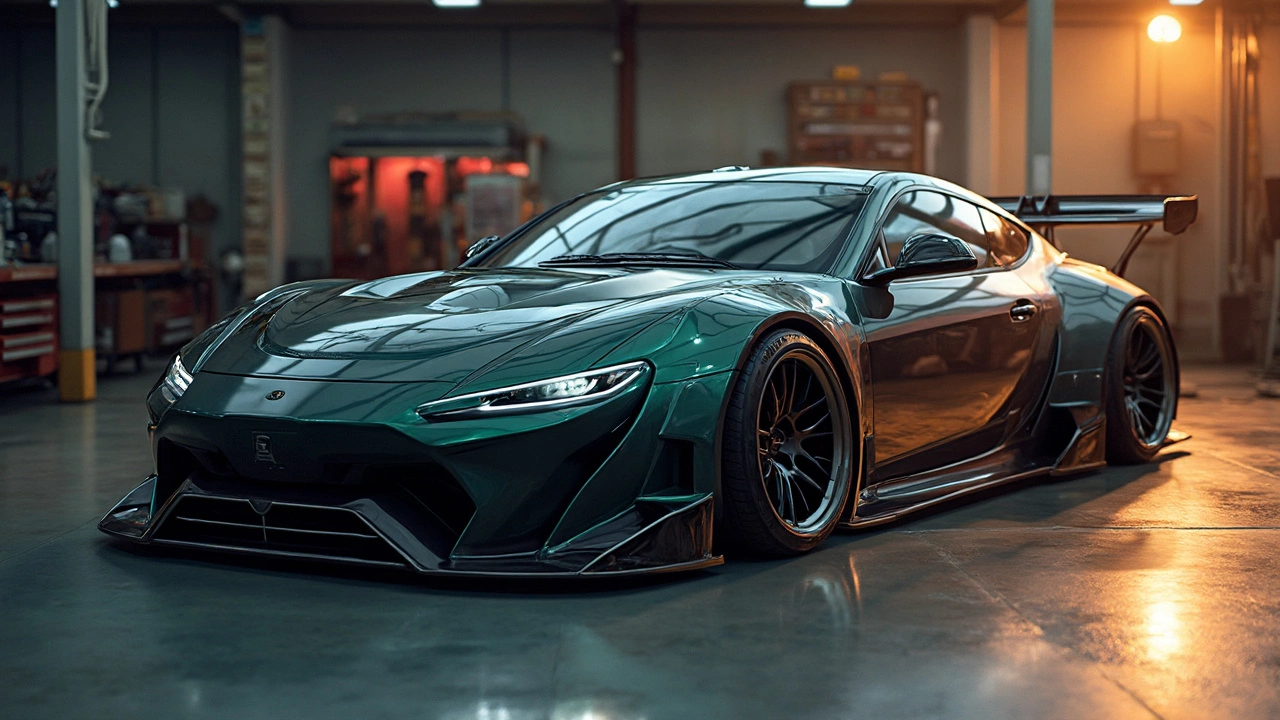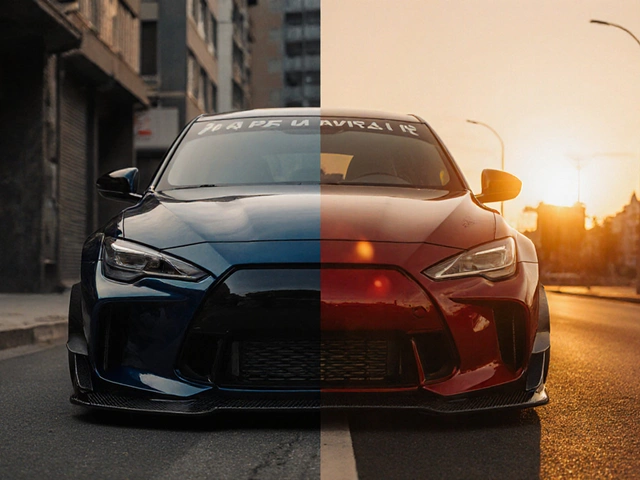Ever stared at a sleek ride on the road and wondered how it got that cool, edge-of-the-future look? Chances are, part of the magic is a full body kit. So, what exactly is this kit? Basically, it's a collection of parts—think bumpers, side skirts, spoilers—that transforms your car into something special. And it's not just about looks; sometimes these kits can even improve performance. Yup, you heard right.
Full body kits are for those who want their vehicle to stand out from the cookie-cutter crowd and feel unique. Whether you're a speed enthusiast looking for better aerodynamics or you just want your car to be the jaw-dropper in the parking lot, there's likely a kit out there for you. But before you jump in, knowing the ins and outs can save you time, trouble, and cash.
Keep in mind, though, not all kits are created equal. Choosing one involves thinking about materials, fitment, and, of course, your personal style. Dive into the world of body kits, and you'll soon discover all the ways you can make your ride truly one of a kind.
- Understanding Full Body Kits
- Components of a Full Body Kit
- Benefits of Using a Body Kit
- Choosing the Right Kit for Your Vehicle
Understanding Full Body Kits
So, you're considering giving your car a facelift with a full body kit? Great choice! Let's dive into what exactly goes into these kits. Essentially, a full body kit is like a wardrobe makeover for your vehicle. It includes a set of exterior modifications specifically designed to enhance your car's appearance or performance. But these aren't just for show—many kits are built with aerodynamics in mind, letting you slice through the air with a bit more grace.
What's in the Box?
A typical full body kit can include components like front and rear bumpers, side skirts, spoilers, and sometimes fenders. These parts can come in different materials such as fiberglass, carbon fiber, or polyurethane. Each material has its own perks. For instance, fiberglass is lightweight and offers a sleek finish, but it's not as durable as polyurethane, which can better handle impacts.
- Fiberglass: Lightweight, easy to paint, but can crack under pressure.
- Polyurethane: Highly durable, flexible, and can withstand minor impacts.
- Carbon Fiber: Super strong and light, but often more expensive.
The Purpose
The car body's transformation is sometimes purely aesthetic, transforming your ride into a head-turner. But there's also a practical side. For instance, a well-designed spoiler can provide better traction at high speeds by increasing the downforce on the rear wheels. Similarly, aerodynamically shaped bumpers reduce drag, helping your car go that extra mile with less fuel.
Now, it's important to understand that installing a body kit isn't just a plug-and-play activity. Compatibility with your vehicle's model makes a big difference. Kits are often designed specifically for certain makes and models, ensuring a seamless fit.
Ready for a Makeover?
Thinking of going ahead with a kit? Consider not only the look you want but also the material and its impact on your car's performance. After all, every addition should reflect your personal style while suiting your daily driving needs.
Components of a Full Body Kit
Alright, let's break down what comes in a full body kit and why you might want these different parts. Think of it like a wardrobe for your car, giving it a fresh look and sometimes even a boost in performance.
Front and Rear Bumpers
The bumpers are usually the stars of any body kit. Front bumpers can reduce lift and improve aerodynamics, which is great if you're into driving fast. They can give your vehicle a meaner look or a more polished finish. Rear bumpers often complement the front, keeping the whole aesthetic of the car consistent.
Side Skirts
Ever noticed those sleek panels running along the vehicle's sides? Side skirts aren't just for show; they can help reduce air turbulence created during driving, contributing to better aerodynamic performance. This helps in stabilizing your car at higher speeds.
Spoilers
These are pretty popular and for good reason. Spoilers can enhance downforce on your car, making it stick better to the road. While they add a sportier vibe to your vehicle, they're also functional for those into serious driving.
Diffusers
Located at the rear, diffusers channel the airflow and can significantly improve your car's aerodynamic profile. This part is essential if you're looking at maximizing your car's performance aspect with a full body kit.
Fender Flares
If you're planning on going for some wider wheels and tires, fender flares have got you covered, literally. They extend your car body to cover those extra inches and keep your ride both legal and stylish.
Choosing the right components for your car body kits can turn your vehicle into an eye-catching powerhouse. Keep your car’s make and model in mind to ensure everything fits like a glove, and remember, quality matters, so always go for the parts made of durable materials like fiberglass, polyurethane, or carbon fiber.

Benefits of Using a Body Kit
So, you’re thinking about sprucing up your ride with a full body kit, but you’re curious about what benefits it'll bring to the table. Well, for starters, body kits are a game-changer when it comes to style. Imagine your car turning heads as it cruises down the street, rocking a unique look that sets it apart from the rest.
Style and Personalization
Let's be real, who doesn’t love a personal touch to their ride? One of the top reasons folks opt for car body kits is the chance to add their flair. You get to choose the design, the color, and even the finicky little details. It’s like tailoring a custom suit but for your car. Whether you’re rolling up to a car meet or just out and about, your car will shout your style.
Improved Aerodynamics
Aside from looks, some body kits, especially those fitted with spoilers and diffusers, can enhance aerodynamics. When designed right, these elements can reduce drag, increasing fuel efficiency, and offer better handling at high speeds. Not every kit will achieve this, but if you're strategic about the one you pick, your car might not just look fast, it could actually be faster!
Resale Value Boost
Thinking long term, adding a body kit can amp up your car's resale value. A car that stands out is generally more appealing to potential buyers. As long as the modifications are tasteful and not over the top, they can recoup a good chunk of your investment in the body kit.
Includes Quality Materials
Good kits are made from quality materials like fiberglass, polyurethane, or carbon fiber. Each has its perks—fiberglass can be lighter, carbon fiber is stronger. Of course, the material you choose will depend on what you're looking for, but know that investing in quality could mean a longer lifespan with fewer damages and repairs down the line.
Choosing the Right Kit for Your Vehicle
Picking the right full body kit for your car isn't as simple as grabbing one off the shelf. It's about finding that perfect fit, style, and material. You want this investment to last, right? Let's break this down into steps that will make the choice less daunting.
1. Know Your Car Model
First things first, not all car body kits are universal. They're usually made to fit specific models. Check the manufacturer's descriptions to ensure the kit is compatible with your car's make and model. This prevents the annoying dilemma of having parts that just won’t fit.
2. Material Matters
Not all kits are created with the same material. You'll find options like fiberglass, polyurethane, and carbon fiber. Here’s a quick breakdown:
- Fiberglass: It's affordable and easy to customize, but it's not as durable. Ideal if you're on a budget and not planning to go off-roading.
- Polyurethane: A bit pricier, but more flexible and durable than fiberglass. Great for everyday use.
- Carbon Fiber: The high-end choice. It’s super strong and lightweight, often used for performance vehicles, albeit expensive.
3. Style it Right
Body kits come in various styles from aggressive racing looks to sleek, minimal designs. Consider what vibe you're going for. Do you want a sporty look or something more subtle that'll boost your car’s aesthetic without drawing too much attention?
4. Budget Wisely
Costs can range widely. A basic kit might start at a few hundred dollars, but high-end options can jump into thousands. You also have to factor in the professional installation costs unless you're ready to DIY. Always compare costs against quality and ensure you're not sacrificing durability for a lower price.
5. Installation Ease or Complexity
Some kits you can bolt on with regular garage tools, while others might need professional help. If you're a DIY enthusiast, read installation guides before buying. If not, check with local shops—some have package deals for the kit and installation.
| Material | Price Range | Durability |
|---|---|---|
| Fiberglass | $300 - $700 | Medium |
| Polyurethane | $600 - $1000 | High |
| Carbon Fiber | $2000+ | Very High |
With these tips, you’re now armed with the intel to make a solid choice. Picking the right kit is a bit like choosing the right outfit for your car. It's about the perfect balance between looks, performance, and cost.




